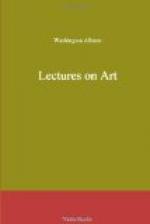If this be true, as we doubt not, we have at least one evidence, where it might not be looked for, that there is that in Truth which is satisfying of itself. But a stronger testimony may still be found where, from all a priori reasoning, we might expect, if not positive pain, at least no pleasure; and that is, where we find it united with human suffering, as in the deep scenes of tragedy. Now it cannot be doubted, that some of our most refined pleasures are often derived from this source, and from scenes that in nature we could not look upon. And why is this, but for the reason assigned in the preceding instance of a still-life picture? the only difference being, that the latter is addressed to the senses, and the former to the heart and intellect: which difference, however, well accounts for their vast disparity of effect. But may not these tragic pleasures have their source in sympathy alone? We answer, No. For who ever felt it in watching the progress of actual villany or the betrayal of innocence, or in being an eyewitness of murder? Now, though we revolt at these and the like atrocities in actual life, it would be both new and false to assert that they have no attraction in Art.
Nor do we believe that this acknowledged interest can well be traced to any other source than the one assumed; namely, to the truth of relation. And in this capacity does Truth stand to the Imagination, which is the proper medium through which the artist, whether poet or painter, projects his scenes.
The seat of interest here, then, being in the imagination, it is precisely on that account, and because it cannot be brought home to self, that the pleasure ensues; which is plainly, therefore, derived from its verisimilitude to the actual, and, though together with its appropriate excitement, yet without its imperative condition, namely, its call of life on the living affections.
The proper word here is interest, not sympathy, for sympathy with actual suffering, be the object good or bad, is in its nature painful; an obvious reason why so few in the more prosaic world have the virtue to seek it.




